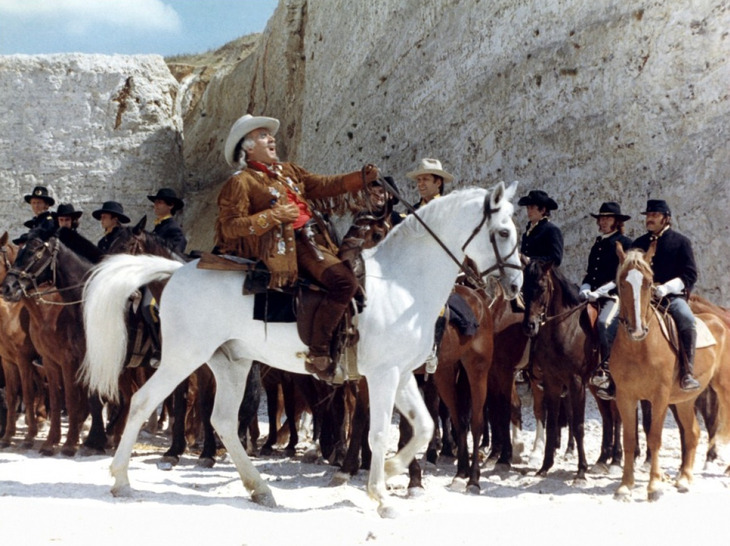
A farcical, anti-imperialist Western set in the barren and empty urban landscape left by the demolishment of Les Halles in Paris.
« J’ai écrit et réalisé ce film pour tous les enfants du monde. Le western exprime de façon simple et élémentaire les concepts: Dieu, Famille, Patrie. J’avais envie de reprendre ces idées et de les faire éclater par le rire. »
Marco Ferreri1
“Last time around, Marco Ferreri’s idea for a serious comedy was to shuttle four bored Parisians (Marcello Mastroianni, Michel Piccoli, Ugo Tognazzi, and Philippe Noiret) off to a country estate and watch them eat and screw themselves to death – a premise yielding La Grande Bouffe, one of the more intriguing morsels in last year’s French movie fare. The sensational notion of Ferreri’s latest, Don’t Touch the White Woman, is to set an honest-to-God Western in the ruins of Les Halles, the wholesale food market, which Zola called ‘the belly of Paris’ and which was banished to the suburbs a few years ago. Ferreri replaces that demolished culinary circus with all the ingredients needed for a grand-scale horse opera: the same male leads as La Grande Bouffe, and no less a white woman than Catherine Deneuve, plus all the open spaces and horses that a European Western freak could ask for. The result is slightly surreal, satirically aimed slapstick, with the Forces of American Imperialism battling the Combined Resources of the Third World. Mastroianni, as General Custer, slaps his gloves and stamps his boot in deference to Puritanism and a picture of Richard Nixon; Piccoli, deftly lampooning an American accent as Buffalo Bill, recounts past exploits in a local bar; a host of “Indians” - mainly Chileans, Colombians, Vietnamese, and Ugo Tognazzi – plot their strategies before the final massacre. But Ferreri’s own strategy is to take off from this semiallegory into a relaxed appreciation of sheer buffoonery, turning various locations (including Notre Dame) into facets of his private sandbox and appearing himself as an interested reporter.”
Jonathan Rosenbaum2
“Les Halles was a biosphere, a living embodiment of the chain of production and consumption, an exchange where commerce remained as personal and sensual as it had been before advertising and marketing were invented, a tremendous social equalizer, a place where the jobless could always find pickup work and the hungry could scrounge for discarded but acceptable food, a hub with its own culture and customs varnished by nearly a millennium of use. It wasn’t just the stomach of Paris but its soul. It was doomed by administrative decree in 1960 and demolished beginning in 1969, in favor of a wholesale-only market in distant suburban Runigs, and replaced by that urbanist cure-all, an espace vert. Marco Ferreri’s 1974 Don’t Touch the White Woman! belongs to a subgenre peculiar to that time, the farcical revisionist Western. It stars Marcello Mastroianni as a dim George A. Custer, Michel Piccoli as a mincing Buffalo Bill, and Catherine Deneuve as the titular white woman. Much of it takes place in a vast expanse of yellow that looks convincingly like the desert of the southwestern United States – until the camera draws back and you realize that it is instead the great pit dug out under the emplacement of Les Halles, the future site of the shopping mall and of the Châtelet-Les Halles RER station. Cavalry charges thunder down Rue Rambuteau, troops mass in front of the Bourse du Commerce, and then there is the poignant spectacle of hundreds of Native Americans, played by black-haired Parisians, being forced to march away from their lands along the deep flank of the pit, their Trail of Tears apparently endless even though it cannot be more than about five blocks long.”
Luc Sante3
« Touche pas à la femme blanche fut une aventure qui allait recevoir un accueil réservé. Peut-être qu’après La Grande Bouffe, le public s’attendait à un autre film du genre scandaleux et que dans celui-ci il n’y a au contraire qu’une transposition d’époque, de costumes, d’événements. C’est un film surréaliste dont la portée satirique échappe sans doute à beaucoup de spectateurs. Je sais que nous autres acteurs, complices du réalisateur, nous l’avons fait avec beaucoup d’enthousiasme. Quand il dit que c’est un western pour les enfants, c’est tellement vrai que nous les acteurs, on l’a joué comme on le ferait pour les enfants, comme on le ferait avec des marionnettes. »
Marcello Mastroianni4
- 1Delphine Simon-Marsaud, « Histoire orale de Touche pas à la femme blanche (Marco Ferreri, 1974), » La Cinémathèque française, 18 novembre 2021.
- 2Jonathan Rosenbaum, “Don’t Touch the White Woman,” 23 March 2021.
- 3Luc Sante, The Other Paris. An illustrated journey through a city's poor and Bohemian past (London: Faber & Faber, 2015).
- 4Delphine Simon-Marsaud, « Histoire orale de Touche pas à la femme blanche (Marco Ferreri, 1974), » La Cinémathèque française, 18 novembre 2021.

